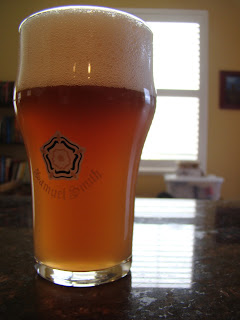=====
 BRING IT ON DIPA
BRING IT ON DIPAAppearance: (Chill) hazy golden orange color, big off-white head that has a good bit of staying power. In pouring, the beer/bottle yeast can have a strange pinkish hue. Becomes very clear when warm.
Smell: Pine, onion, some alcohol, a little bread as it warms.
Taste: Pine & onion hanging around from the aroma along with some diesel hop character. Some perception of sweetness that may be coming from the hops. Finishes with a balanced bitterness, definitely not overly bitter.
Mouthfeel: On the thin side, though not overly so. Medium carbonation; hits the tongue without filleting it. A little tongue numbing.
Overall: Probably my most successful attempt at a double IPA. This one reached the degree of attenuation I was seeking to get away from cloying malt sweetness; I may even want to bump it back up a couple points next time to retain a bit more malt backbone. Malt definitely didn't get in the way here, and I'm tempted to add in a higher percentage of character grains (Munich, Vienna, aromatic, or even a bit of crystal) in the future. I'm slowly coming to grips with the fact that the Amarillo hops I've had in the last couple years do not have the same citrus characteristics that endeared this varietal to me originally. I'm getting a lot more of the onion/garlic/diesel now. It doesn't always come out--and I sure hope it doesn't on the session IPA I'm brewing today--but I'm missing the mark more often than not with this hop.
=====
Winter Porter
Appearance: Deep brown/black body with clear red-brown highlights; a little bit of light brown foam hangs out at the rim for a while. While I'd like more head on this beer, otherwise it looks pretty much like spot on for the style.
Smell: I've given this one fifteen to twenty minutes to warm up before sampling, so much of the diacetyl present in this batch--which has been widely variable, bottle to bottle--may have blown off. Some butter popcorn remains, combining with the dark grains and a mineral character to give an impression of sharp mineral roastiness. While not terrible, the diacetyl buttery character has been so strong on other bottles as to make this nigh undrinkable.
Taste: I'm struggling here. Not assertively roasty, though not chocolatey either. Has a certain tang that I associate with the dark malts to a degree, but I can't quite pin with a descriptor. Not the best.
Mouthfeel: Medium-full body from the residual sweetness and slight residual diacetyl. Does retain a certain creaminess, especially when chewed a bit. Not unpleasant.
Overall: Not my favorite porter, to be sure. I've had spectacular results from this yeast (WY1469) in the past, but on this batch it really took a bad turn. This was my first real experience with diacetyl, and it's been strong enough to encourage me to do a diacetyl rest on every beer from here on out. It's been a few years now since I had Flag Porter, but my recollection of that beer was my guide here. My quest for a really badass "English/brown" porter continues.










